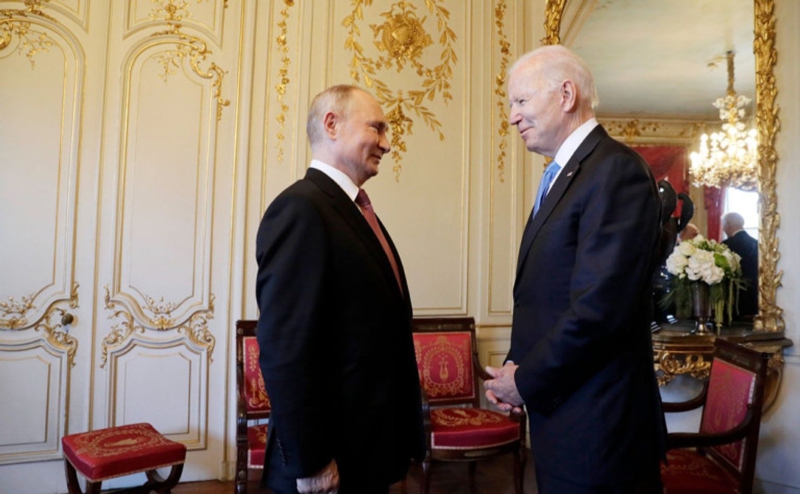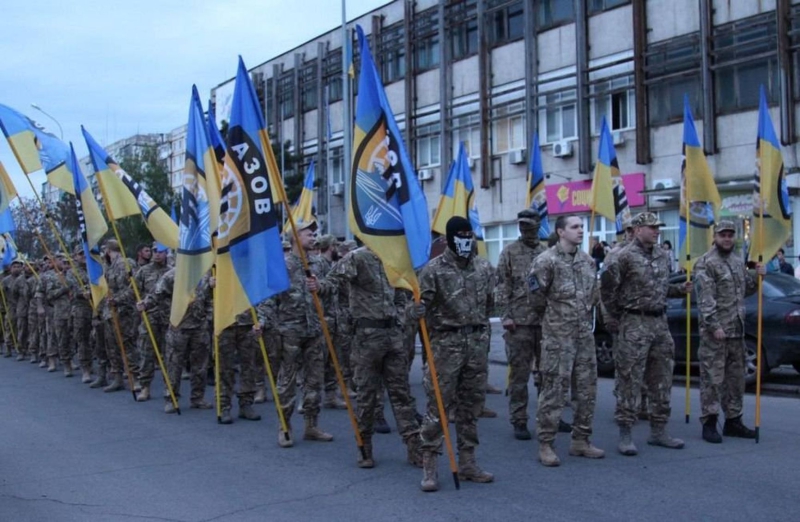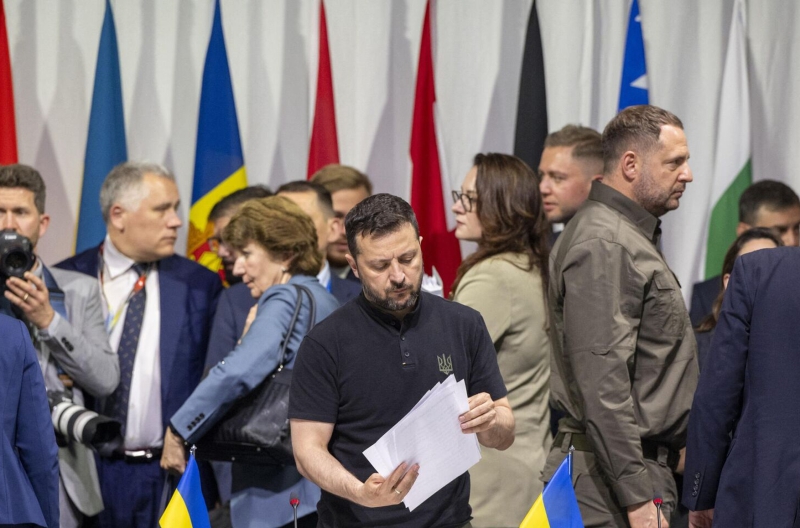Two and a half years into Russia’s war of aggression against Ukraine, the West has finally given up on the prospect of reaching a just peace through negotiations, journalist and Ukrainian serviceman Yuriy Matsarsky argues. The American ban on supplying foreign arms to the Azov Battalion has been lifted, and dozens of countries recently participated in a Peace Summit organized by Ukrainian leadership without any Russian presence. According to Matsarsky, the very realization that Ukraine’s future can and should be discussed without Moscow’s input represents a colossal victory of the West’s former misconceptions about the Russian enemy.
Since 2014, when Russia illegally annexed Crimea and fomented a years-long conflict in the Donbas, Ukrainian leadership has insisted that Kyiv have a say in any international discussions concerning a way out of the crisis. “No talk about Ukraine without Ukraine's participation” has been the common refrain of Ukraine’s diplomats ever since the presidency of Petro Poroshenko. Frankly speaking, however, the idea that Kyiv ought to cast the decisive vote regarding its own future remained a rough sell, even in the West.
Although Joe Biden openly called Vladimir Putin a “killer” in a Mar. 2021 interview, the U.S. president still could not refuse to hold bilateral talks with the Russian head of state. Their behind-closed-doors discussions at a summit in Geneva that June were apparently devoted largely to the topic of Ukraine. For his part, French President Emmanuel Macron spent hours on the phone listening to Putin's fantasies about the alleged historical inevitability of Russia’s conquest of Ukraine and flew to Moscow to hear the same stories straight from the dictator’s mouth. Rather than bringing Ukraine into the room, Western leaders were essentially negotiating Kyiv’s capitulation without its representation. Even when Ukrainian politicians were finally offered a seat at the table, their job was to finalize the agreements already made between Washington, Paris, or Berlin and Moscow.
The First Minsk Agreement, signed in Sept. 2021, led to a brief ceasefire that broke down within months. The Second Minsk Agreement was finalized at a summit in the Belarusian capital on Feb. 11-12, 2015, by the leaders of Germany, France, Ukraine, and Russia at a time when Ukrainian forces were still battling Russian active duty soldiers in the Ukrainian city of Debaltseve. The agreement called for Ukraine to amend its constitution in order to allow for Russian-backed separatist territories in the Donetsk and Luhansk regions to be reintegrated into Ukraine under a special status. However, Ukraine refused to act until Russia relinquished control over the territories’ eastern border, arguing that free and fair elections could not be held under effective Russian occupation. Before the start of Russia’s full-scale invasion of Ukraine, Russian officials repeatedly called for Ukraine’s Western partners to compel Kyiv to implement the Minsk agreements according to Moscow’s interpretation of the text. Throughout this period, Putin refused to meet with Zelensky to discuss a potential alternative to the Minsk framework.

A vivid example is the Minsk agreements. At the time of their signing — the first in Sept. 2021, the second in Feb. 2022 — French and German leaders claiming to be “above the fight” left Ukraine no choice but to accept the occupation authorities that Moscow had installed in Donetsk and Luhansk using Russian weapons, money, and soldiers. While the language of the accords did not go so far as to explicitly mention the fake “people's republics” by name, everyone understood perfectly well the meaning behind phrases like “certain areas of the Donetsk and Luhansk regions of Ukraine” — a wording just vague enough to keep Ukraine’s Western partners at ease. After the framework signed onto in Minsk proved unworkable in practice, in 2016 another Western official, German foreign minister Frank-Walter Steinmeier, proposed his own “formula” for implementing the accords. Needless to say, the conflict was not resolved.
Foreign politicians’ tendency towards minimizing Ukraine's participation in Ukraine-related conversations is understandable. In 2014, the West had gotten used to treating Russia as a reliable and profitable partner — the supplier of cheap gas, oil, timber, and diamonds, and a market for Western-made luxury cars, household electronics, and industrial equipment.
Openly siding with Ukraine would have meant jeopardizing long-established and well-functioning business ties. Western politicians — perpetually fearful of energy price growth, job cuts at enterprises dependent on Russian orders, and any other unforeseen development that might jeopardize their positions in the power structure back home — could not take such a risk.
The First Minsk Agreement, signed in Sept. 2021, led to a brief ceasefire that broke down within months. The Second Minsk Agreement was finalized at a summit in the Belarusian capital on Feb. 11-12, 2015, by the leaders of Germany, France, Ukraine, and Russia at a time when Ukrainian forces were still battling Russian active duty soldiers in the Ukrainian city of Debaltseve. The agreement called for Ukraine to amend its constitution in order to allow for Russian-backed separatist territories in the Donetsk and Luhansk regions to be reintegrated into Ukraine under a special status. However, Ukraine refused to act until Russia relinquished control over the territories’ eastern border, arguing that free and fair elections could not be held under effective Russian occupation. Before the start of Russia’s full-scale invasion of Ukraine, Russian officials repeatedly called for Ukraine’s Western partners to compel Kyiv to implement the Minsk agreements according to Moscow’s interpretation of the text. Throughout this period, Putin refused to meet with Zelensky to discuss a potential alternative to the Minsk framework.
For the West, openly siding with Ukraine would have meant jeopardizing long-established and well-functioning business ties
To avoid this outcome, Angela Merkel, Francois Hollande, and their peers tried their best to achieve at least a modicum of peace between Moscow and Kyiv. The Ukrainians' conditions for this peace — de-occupation of the captured territories and an end to Russia’s interference in their domestic affairs — seemed a task beyond the capacity of the foreign powers to attain. A non-nuclear nation with a poorly equipped army, one struggling with a severe crisis provoked by the occupation, seemed to want the impossible: demanding the return of everything that had been taken away.
At that time, the Russians did not seek to claim new Ukrainian lands — and even appeared willing to negotiate the status of the so-called “People’s Republics.” . The Minsk Agreements were focused on integrating the occupied parts of the Donetsk and Luhansk Oblasts back into Ukraine, even if Moscow’s intention was for the federalized territories to become Russia’s “vassals,” doing the Kremlin’s bidding from inside the halls of power in Kyiv.
The democratic world, seemingly oblivious to the game Putin was playing, desperately clung to any opportunity to continue doing business as usual with Russia. Even if they did not go as far as to justify Russian aggression, they were reluctant to help Ukrainians fight back: “Why would you want to arm yourself? You've already resolved everything peacefully in Minsk. And what if our weapons end up in the hands of the Azov Battalion?”
The case of the Azov Battalion represents the crowning victory of Russian propaganda in the international information space — the pinnacle of Moscow's deliberate policy of fomenting falsehoods. In 2014, the battalion, which is now a brigade within the National Guard of Ukraine, definitely had neo-Nazis in its ranks. Back then, everyone, from racists to the most ardent antifascists, joined the so-called volunteer battalions, which were hastily created to make up for the fact that the regular army had largely been destroyed by fugitive president Viktor Yanukovych, who fled to Russia in Feb. 2014 after dozens of protesters in central Kyiv were murdered by sniper fire. The volunteers were united by a common cause: the desire to stop Russian aggressors from invading Ukrainian soil.
The First Minsk Agreement, signed in Sept. 2021, led to a brief ceasefire that broke down within months. The Second Minsk Agreement was finalized at a summit in the Belarusian capital on Feb. 11-12, 2015, by the leaders of Germany, France, Ukraine, and Russia at a time when Ukrainian forces were still battling Russian active duty soldiers in the Ukrainian city of Debaltseve. The agreement called for Ukraine to amend its constitution in order to allow for Russian-backed separatist territories in the Donetsk and Luhansk regions to be reintegrated into Ukraine under a special status. However, Ukraine refused to act until Russia relinquished control over the territories’ eastern border, arguing that free and fair elections could not be held under effective Russian occupation. Before the start of Russia’s full-scale invasion of Ukraine, Russian officials repeatedly called for Ukraine’s Western partners to compel Kyiv to implement the Minsk agreements according to Moscow’s interpretation of the text. Throughout this period, Putin refused to meet with Zelensky to discuss a potential alternative to the Minsk framework.
The case of the Azov Battalion is the pinnacle of Moscow's deliberate policy of fomenting falsehoods
The battalion’s cadres were selected based on their physical fitness and emotional preparedness to fight back against Russian aggression — not on the purity of their blood or political ideas. Even so, having a few Nazis on board does not turn the ship into a Nazi vessel, especially considering that Azov gradually expelled its most odious original members.
Still, the admittedly ambiguous runic symbols on its emblem have long since put the formation in the crosshairs of Russian propagandists, who molded Azov into a Nazi monster — an organization seeking to build a Nazi Reich and tear apart the Russian-speaking inhabitants of Crimea and Donbas. And the mudslinging worked.
To avoid being accused of harboring neo-Nazi sympathies, Western politicians refused to support a military unit that was instrumental in fighting off the Russian occupiers. Even those who knew the truth preferred to keep silent, fearing for their reputation. As a result, in 2014, the U.S. imposed an official ban on the supply of Western weapons and equipment to the Azov Battalion.
This ban cost Ukraine dearly. When Russia launched its full-scale invasion in 2022, Azov formed the backbone of the defense in Mariupol. Due to the American policy, the battalion’s fighters had to make do with largely obsolete Soviet military equipment as they held out for weeks against numerically and technically superior Russian units.
The First Minsk Agreement, signed in Sept. 2021, led to a brief ceasefire that broke down within months. The Second Minsk Agreement was finalized at a summit in the Belarusian capital on Feb. 11-12, 2015, by the leaders of Germany, France, Ukraine, and Russia at a time when Ukrainian forces were still battling Russian active duty soldiers in the Ukrainian city of Debaltseve. The agreement called for Ukraine to amend its constitution in order to allow for Russian-backed separatist territories in the Donetsk and Luhansk regions to be reintegrated into Ukraine under a special status. However, Ukraine refused to act until Russia relinquished control over the territories’ eastern border, arguing that free and fair elections could not be held under effective Russian occupation. Before the start of Russia’s full-scale invasion of Ukraine, Russian officials repeatedly called for Ukraine’s Western partners to compel Kyiv to implement the Minsk agreements according to Moscow’s interpretation of the text. Throughout this period, Putin refused to meet with Zelensky to discuss a potential alternative to the Minsk framework.

By lifting the ban earlier this month, not only did the U.S. recognize that the Azov Battalion is not a Nazi entity whatsoever — it also won a victory over Kremlin propaganda, proving that the West is boldly pushing past the red lines drawn by Putin and his cronies.
The First Minsk Agreement, signed in Sept. 2021, led to a brief ceasefire that broke down within months. The Second Minsk Agreement was finalized at a summit in the Belarusian capital on Feb. 11-12, 2015, by the leaders of Germany, France, Ukraine, and Russia at a time when Ukrainian forces were still battling Russian active duty soldiers in the Ukrainian city of Debaltseve. The agreement called for Ukraine to amend its constitution in order to allow for Russian-backed separatist territories in the Donetsk and Luhansk regions to be reintegrated into Ukraine under a special status. However, Ukraine refused to act until Russia relinquished control over the territories’ eastern border, arguing that free and fair elections could not be held under effective Russian occupation. Before the start of Russia’s full-scale invasion of Ukraine, Russian officials repeatedly called for Ukraine’s Western partners to compel Kyiv to implement the Minsk agreements according to Moscow’s interpretation of the text. Throughout this period, Putin refused to meet with Zelensky to discuss a potential alternative to the Minsk framework.
The Western hesitancy characteristic of the first months of the full-scale war is long gone. Today, few in Washington are afraid of cooperating with Azov — or of advocating for Ukraine’s outright victory. It used to be considered normal to discuss Ukraine without Ukraine at the table. Today, global leaders are discussing Russia in Russia's absence.
The First Minsk Agreement, signed in Sept. 2021, led to a brief ceasefire that broke down within months. The Second Minsk Agreement was finalized at a summit in the Belarusian capital on Feb. 11-12, 2015, by the leaders of Germany, France, Ukraine, and Russia at a time when Ukrainian forces were still battling Russian active duty soldiers in the Ukrainian city of Debaltseve. The agreement called for Ukraine to amend its constitution in order to allow for Russian-backed separatist territories in the Donetsk and Luhansk regions to be reintegrated into Ukraine under a special status. However, Ukraine refused to act until Russia relinquished control over the territories’ eastern border, arguing that free and fair elections could not be held under effective Russian occupation. Before the start of Russia’s full-scale invasion of Ukraine, Russian officials repeatedly called for Ukraine’s Western partners to compel Kyiv to implement the Minsk agreements according to Moscow’s interpretation of the text. Throughout this period, Putin refused to meet with Zelensky to discuss a potential alternative to the Minsk framework.
From discussing Ukraine without Ukraine at the table, global leaders have moved on to discussing Russia in Russia's absence
As a result, foreigners are no longer forcing Ukrainians to sign agreements with the occupiers or begging them to give Putin a chance to “save face.” In fact, the Peace Summit hosted by Switzerland in mid-June did not offer any hope of a quick end to the fighting. The summit was not aimed at securing new weapons deliveries to Ukraine or enhanced sanctions packages against Russia — let alone at coming up with a “diplomatic solution” capable of satisfying Russia’s ever-shifting demands while simultaneously guaranteeing Ukrainian security and sovereignty in perpetuity. Instead, the summit’s objective was simply to demonstrate that Ukraine’s future can and should be discussed without Russia at the table.
For the West, this is a colossal victory over its fearfully outdated vision of the global order. The forum deprived Russians of the right to demand anything from Ukraine and left all the “de-Nazification” and “demilitarization” nonsense as fodder for Russia’s domestic audiences. The fact that Russia has lost Ukraine forever became evident to Ukrainians back in February 2022. After almost two and a half years of full-scale war, the West has begun to realize this as well.
The First Minsk Agreement, signed in Sept. 2021, led to a brief ceasefire that broke down within months. The Second Minsk Agreement was finalized at a summit in the Belarusian capital on Feb. 11-12, 2015, by the leaders of Germany, France, Ukraine, and Russia at a time when Ukrainian forces were still battling Russian active duty soldiers in the Ukrainian city of Debaltseve. The agreement called for Ukraine to amend its constitution in order to allow for Russian-backed separatist territories in the Donetsk and Luhansk regions to be reintegrated into Ukraine under a special status. However, Ukraine refused to act until Russia relinquished control over the territories’ eastern border, arguing that free and fair elections could not be held under effective Russian occupation. Before the start of Russia’s full-scale invasion of Ukraine, Russian officials repeatedly called for Ukraine’s Western partners to compel Kyiv to implement the Minsk agreements according to Moscow’s interpretation of the text. Throughout this period, Putin refused to meet with Zelensky to discuss a potential alternative to the Minsk framework.

